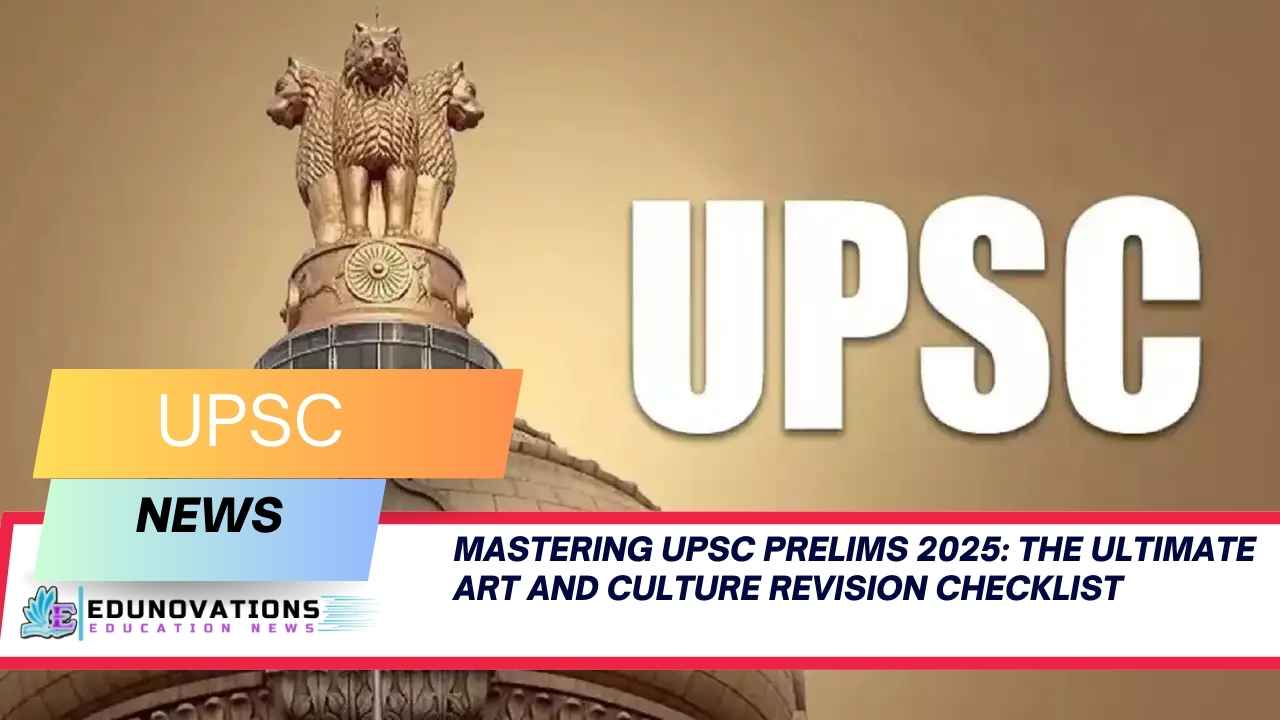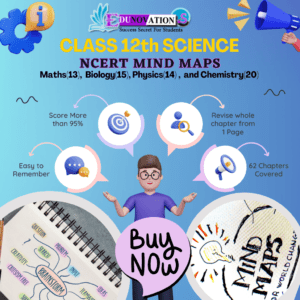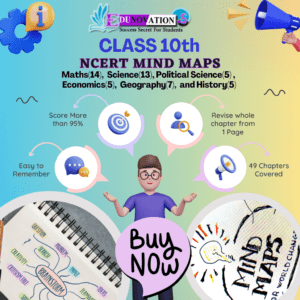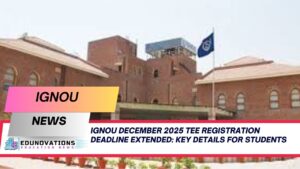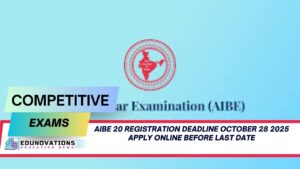Comprehensive guide to UPSC Prelims 2025 Art and Culture revision checklist, featuring key topics, strategies, and resources to enhance your preparation.
As the UPSC Prelims 2025 approaches, aspirants are intensifying their revision strategies, particularly focusing on the Art and Culture segment. This area, rich in historical significance and contemporary relevance, demands a structured and thorough approach. This article presents a detailed revision checklist, integrating essential topics and effective preparation techniques to bolster your readiness for the examination.
Understanding the Importance of Art and Culture in UPSC Prelims
Art and Culture form a significant portion of the UPSC Prelims, often intertwined with current affairs and historical contexts. A well-rounded understanding of this segment not only aids in answering direct questions but also enhances comprehension of India’s diverse heritage.
📘 Comprehensive Revision Checklist for UPSC Prelims 2025 Art and Culture
A targeted and structured approach is essential when preparing the UPSC Prelims 2025 Art and Culture Revision Checklist. Art and culture questions can be tricky — often requiring nuanced understanding rather than rote learning. Below is a well-segmented revision checklist designed to cover the vast landscape of Indian art, culture, and heritage that aligns with the evolving trends in UPSC Prelims 2025.
🏛️ 1. Ancient Indian Art and Architecture
A strong foundation in ancient Indian history is crucial to master the UPSC Prelims 2025 Art and Culture Revision Checklist. This section not only reflects early civilizational excellence but also contributes to modern identity.
- Indus Valley Civilization: Focus on city layouts like Mohenjo-Daro, seals with animal motifs, terracotta figurines, and urban sanitation systems.
- Mauryan Period: Understand the imperial style of art such as Ashokan pillars, Lion Capital (India’s national emblem), and rock-cut caves at Barabar Hills.
- Gupta Era: Recognized as the Golden Age of Indian art, especially temple architecture (Dashavatara Temple), intricate sculptures, and mural paintings in Ajanta Caves.
🕌 2. Medieval Indian Art and Culture
The UPSC Prelims 2025 Art and Culture Revision Checklist must incorporate the rich tapestry of medieval India’s spiritual, architectural, and regional developments.
- Bhakti and Sufi Movements: Revise the lives and teachings of saints like Kabir, Guru Nanak, and Chishti saints. Their emphasis on devotion shaped literature and art.
- Mughal Architecture: Study architectural marvels like the Taj Mahal and Humayun’s Tomb. Note Persian aesthetics merged with Indian elements.
- Regional Kingdoms: Explore the temple art of the Cholas (e.g., Brihadeshwara Temple), Hampi’s monuments from Vijayanagara Empire, and Rajput palaces with mural art.
🎨 3. Modern Indian Art and Cultural Renaissance
A crucial part of the UPSC Prelims 2025 Art and Culture Revision Checklist is the modern era, where colonial encounters and nationalism influenced the cultural landscape.
- Colonial Influence: British art schools introduced oil painting and perspective-based drawing; Raja Ravi Varma stood at this crossroad of tradition and modernity.
- Indian National Movement: Understand how art became a political expression — Bharat Mata by Abanindranath Tagore, cultural symbolism in protests.
- Post-Independence Developments: Focus on institutions like the Lalit Kala Akademi and initiatives like SPIC MACAY for cultural preservation and promotion.
💃 4. Performing Arts
One of the more visually engaging parts of the UPSC Prelims 2025 Art and Culture Revision Checklist, performing arts bridge theory with identity.
- Classical Dances: Know the region, costumes, musical instruments, and spiritual themes in Bharatanatyam, Kathak, Kuchipudi, Odissi, Mohiniyattam, etc.
- Music Traditions: Differentiate Hindustani (Tansen, Gharanas) from Carnatic (Thyagaraja, Trinity). Instruments like sitar, veena, and tabla should be noted.
- Theatre and Puppetry: Revise classical forms like Kathakali, Yakshagana, and puppet traditions like Bommalattam and Tholu Bommalata.
🖼️ 5. Visual Arts and Crafts
An indispensable segment of the UPSC Prelims 2025 Art and Culture Revision Checklist is traditional and folk art, often included in one-liner or matching-type questions.
- Painting Styles: Madhubani (Bihar), Pattachitra (Odisha), Warli (Maharashtra), Kalamkari (Andhra Pradesh), and Mughal miniatures.
- Handicrafts: Study tribal and rural crafts—Dokra metalwork, Blue Pottery (Jaipur), and Bidriware. Understand the GI tag relevance.
- UNESCO Recognitions: Be aware of Indian elements in UNESCO’s Intangible Cultural Heritage list, such as Kumbh Mela, Yoga, and Chhau Dance.
🎊 6. Cultural Institutions and Festivals
This last section of the UPSC Prelims 2025 Art and Culture Revision Checklist ties current affairs with static syllabus, helping you connect historical and modern India.
- Major Festivals: Study their religious and cultural background — Diwali (Victory of good over evil), Holi (harvest and spring festival), and Navratri (Durga worship).
- Cultural Bodies: Understand the functioning and contributions of institutions like Sahitya Akademi, Sangeet Natak Akademi, and IGNCA.
- Museums and Heritage Sites: Know key museums (National Museum, Indian Museum) and UNESCO World Heritage Sites like Qutub Minar, Rani ki Vav, and Western Ghats.
Toppers Use Mind Maps to score more than 95%
NCERT Class 11th Commerce Mind Maps
Add to cartOriginal price was: ₹999.00.₹199.00Current price is: ₹199.00.NCERT Class 12th Chemistry Mind Maps
Add to cartOriginal price was: ₹199.00.₹75.00Current price is: ₹75.00.NCERT Class 12th Commerce Mind Maps
Add to cartOriginal price was: ₹999.00.₹199.00Current price is: ₹199.00.NCERT Class 12th Science Mind Maps
Add to cartOriginal price was: ₹999.00.₹199.00Current price is: ₹199.00.NCERT Mind Maps For Class 10th
Add to cartOriginal price was: ₹999.00.₹199.00Current price is: ₹199.00.
Purchase Today
📌 Strategic Add-Ons to the UPSC Prelims 2025 Art and Culture Revision Checklist
To enhance this UPSC Prelims 2025 Art and Culture Revision Checklist, don’t forget to complement your preparation with:
- 📚 NCERT Courses for Basics
- 📰 Daily Cultural Current Affairs
- 📝 Handwritten & Digital Notes
- 🧠 NCERT Mind Maps for Art & Culture
- 🎥 Visual Learning via Videos
- 📥 Free NCERT PDFs Downloads
- ❓ Topic-wise MCQs
- 📄 Detailed Syllabus Coverage
FAQs
1. What is the significance of art and culture in UPSC Prelims 2025?
Art and culture are integral to understanding India’s heritage and are frequently featured in the UPSC Prelims, making them essential for comprehensive preparation.
2. How can I effectively revise art and culture topics?
Utilize structured notes, mind maps, and regular practice of MCQs to reinforce learning and identify areas requiring further study.
3. Are current affairs related to art and culture important for the exam?
Yes, linking historical topics with recent developments enhances understanding and is often tested in the examination.
4. What resources are recommended for art and culture preparation?
Refer to NCERT textbooks, standard reference books, and reliable online platforms offering comprehensive materials and practice questions.
5. How much time should I allocate to art and culture revision?
Allocate regular, focused study sessions, integrating art and culture topics with current affairs to maximize retention and understanding.
6. Can visual aids enhance my preparation?
Yes, visual tools like charts and mind maps can help in better retention and understanding of complex topics.
7. How do I stay updated with cultural current affairs?
Regularly follow reputable news sources, government releases, and dedicated current affairs platforms focusing on cultural developments.The Times of India
8. Are there any specific festivals or events I should focus on?
Yes, understanding the historical and cultural significance of major Indian festivals and events can be beneficial for the exam.
9. How important are UNESCO World Heritage Sites in preparation?
They are significant as they reflect India’s rich cultural heritage and are often included in examination questions.
10. What is the role of cultural institutions in art and culture?
Institutions like the Sangeet Natak Akademi and Lalit Kala Akademi play pivotal roles in preserving and promoting India’s cultural heritage, making them important study topics.

